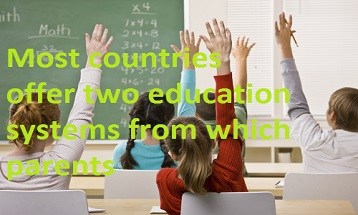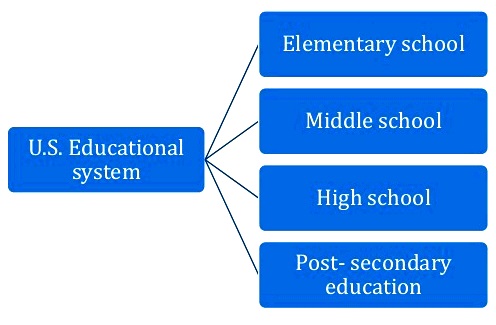Key Features Of Educational Systems Of Different Countries

Education is a complex human scheme geared towards improving students’ cognitive development. We can look at it as an art, which requires specific skills. Teaching is an intricate and interactive exchange of materials from educators to learners so they can relate knowledge to real-life situations. Education occurs in different scenarios across the world with the most common places being the classrooms, community centers, online platforms, museums, and private homes. The formal schooling systems of different countries differ profoundly. Most education systems are multilayered i.e. elementary schools, middle schools, high schools, colleges, universities, and community learning centers for adults.
In the following section, we shall delve into the schooling systems of top countries according to world education rankings.

What countries do well in education?
According to the international league tables, South Korea, Hong Kong, and Finland have the highest scores. Japan, Korea, Singapore, Liechtenstein, and parts of China also top the rankings for particular subjects like Math and Science. There are many reasons why schooling in these nations ranks high. In Finland, for instance, there is one of the most supportive and serene environments for students. The curriculum is renewed regularly and only highly qualified teachers are employed. Let’s check out these characteristics in details.
Finland
Finland emphasizes a welfare society, i.e. supporting every learner no matter what social economic background they hail from. This equality principle applies to other sectors of the country as well. It is a holistic approach whereby citizens pay taxes to support every family. One remarkable thing about Finland schools is that the teaching profession is held in high esteem like any other career such as medicine. Moreover, the teaching programs are very competitive and not every student gets an opportunity. As such, the schools receive highly motivated students most of who do five-year courses up to the Masters level in the universities. Every teacher, whether they teach in primary or university, must hold a master’s degree which is not the case in Nordic countries.
As far as the classroom setting goes, the environment is very interactive and students are allowed to challenge their teachers. So, the typical teacher-oriented teaching style is a thing of the past in Finland. The other notable feature is the local power bestowed on municipal schools. These institutions have the freedom to localize the core curriculum. The government trusts the educators since they are selected meticulously and tasked with tailoring education as per the students’ needs. The curriculum is changed often to improve social interactions, life-long learning, and collaboration. The learning environment is very crucial and so the students are given relaxed atmospheres to learn for life.
The other factors that contribute to a successful teaching system in Finland include smaller class sizes (15-25) in elementary and secondary schools and lack of national exams or a comparison culture. Other countries should emulate the Finnish schooling model and especially the emphasis on highly trained teachers.
South Korea
The culture of testing and examination has deep roots in South Korea. The exams define the curriculum. The examination days are some of the most important days that they make other activities come to a standstill. For instance, planes are diverted to other routes to reduce noises while is stopped near the schools. Basically, Math, languages, and sciences dominate the South Korean curriculum, with special emphasis on English since it is a great factor of social mobility.
There is a strong relationship between exams and social mobility in the education system of South Korea. Competitive public exams are used as means of selection and social mobility. The exam results determine entirely whether you will get a place in a university or a good school. As such, parents offer strong support to their kids. They even hire private tutors for their children.
In essence, South Korean schooling system can be viewed as diligent, orderly, and teacher-led.
Hong Kong
Hong Kong schools focus more on diligence as opposed to natural abilities. Similarly, the country was founded on hard work rather than luck. In the past, in-built class systems never existed and education was the only way to attain social mobility. The citizens believe that educating their kids is one of the best investments in Hong Kong. They insist on diligence and will go ahead and protect is the kids are not given sufficient homework. In fact, 70% of the secondary school students receive private tuition. Those who need online help usually consult cheap assignment help.
The core subjects in Hong Kong are Math, English, and Chinese and the curriculum is followed strictly. Teachers stick to a specific scheme and everything is geared towards exams. Only those who achieve higher marks get a chance in the prestigious institutions. In this countries, students work under pressure especially for the exams. The teaching style is traditional but focused on memorization with understanding. Behind every subject is a theory of learning as opposed to finishing projects for the sake of it. A particular framework has to be followed.
One of the greatest challenges in Hong Kong is the availability of space. On average, every classroom holds 42 students, making it hard to provide individual attention. Sometimes, teachers are forced to use microphones.
American school system
The education system in the USA had different structures set at state level. Most kids start compulsory schooling at five or six years of age which runs for 12 years. The pre-school is followed by elementary and middle school and then high school which splits to junior and senior high school. In the public schools, the system runs from August or September to May or June. The exact dates are determined by the state or individual school. The academic years feature 2 or 3 semesters with breaks in between.
Generally, the American school system is a bit mediocre according to the OECD international rankings. It’s trailing behind the powerhouses like Finland and Korea. For example, it is struggling with Math from a report which showed a mean score below the PISA standard, ranking the country number 26 out of 34 OECD nations.

The variability of the key features of education is reflected in the practice of educators. Their skills, wisdom, values, and professional relations determine the reputation of educational institutions. The features of education have huge impacts on scientific research, values, and politics, as well as the economic wellness of a nation.
